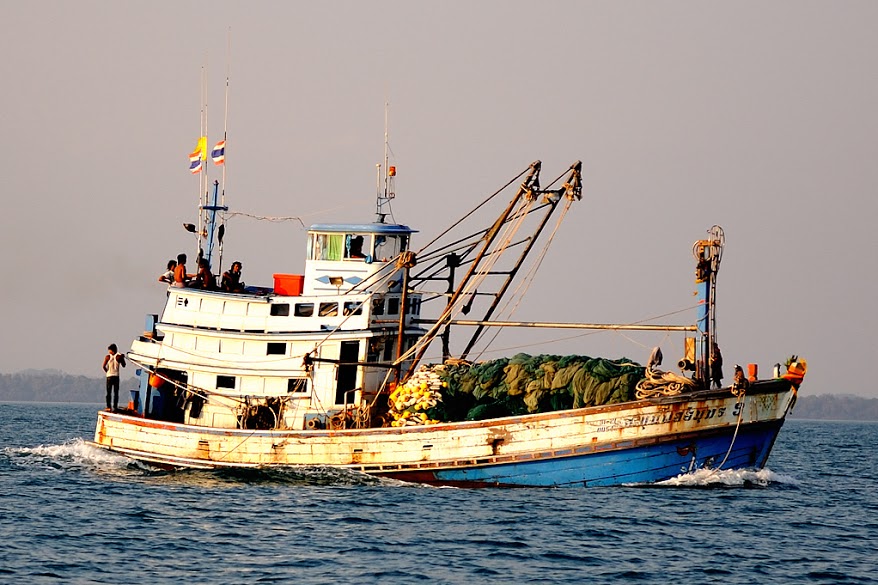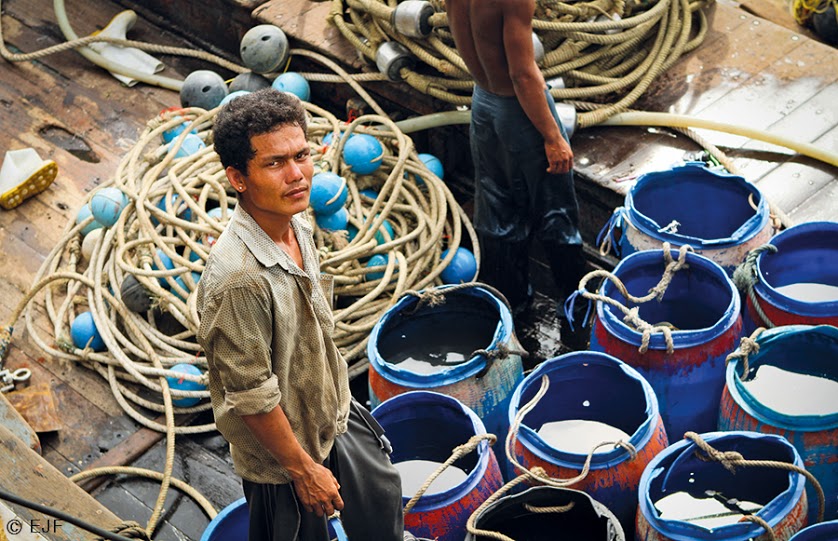- One Thai man was at his most vulnerable when a stranger took an interest in his plight and offered him an easy job sorting fish.
- Such ‘sub-brokers’ typically befriend men in public places, gain their trust and offer them work before selling them on to ‘bounty brokers,’ whom boat captains hire to find labor.
- Some experts say slave labor plays an integral part in keeping the fishing industry afloat.
One night nearly four years ago in Mahachai, a gritty port town near Bangkok, Akaradetch Seri was down on his luck. A fight with his girlfriend had left him out on the streets. Lacking funds, a job and now a home, the former factory worker pondered his next move, bedding down on a park bench, the smell of raw fish lingering in the air.
This would be among Seri’s last nights on Thai soil after becoming one of an unknown number of men trafficked onto boats in the country’s fishing industry.
Contributing $7 billion annually to Thailand’s economy, the industry has been linked to a desperate need for cheap labor, with migrants and poor Thais like Seri often supplying it against their will. As survivors have testified, many are recruited into the industry by deceitful means, a practice that has picked up pace as boat captains struggle to find men to work willingly.
Seri was at his most vulnerable when a stranger approached and took an interest in his plight. After a chat, the man offered him a drink and a place to stay the night. He even said he knew of an easy job sorting fish. A stroke of luck, thought Seri, now 35, who today safe in Mahachai where it all began, speaks haltingly in Thai.
The man mentioned he could stay at a friend’s house, what turned out to be a stark room inhabited by several others. The front door remained bolted, and Seri became worried when asked not to leave under any circumstances.
After several days, the men were taken to a port and loaded into a ship’s barren hull, then ferried to Indonesia and forced to board another vessel to work. Afraid, Seri asked to go back. He was told his passage had been paid for and only his backbreaking labor could buy his freedom.
For the next three years, Seri caught and sorted fish on a Thai-run deep-sea fishing vessel in Indonesian waters, earning a fraction of Thailand’s minimum wage.

Recent exposés by the Associated Press and other media have linked seafood fished by modern-day slaves to Thai companies supplying major brands and supermarkets in Europe and the U.S.
The world’s third largest seafood exporter, Thailand is one of the most overfished regions on the planet, with the catch per unit of effort (CPUE) in the Thai Gulf and Andaman Sea having dropped 86 percent since 1996, according to UK-based NGO the Environmental Justice Foundation.
The dearth has pushed vessels farther into foreign waters, where they often fish illegally, skimming billions of dollars in stolen catches from Indonesia and other Southeast Asian countries. The larger distances make regularly returning to shore less feasible; roving resupply ships make it less necessary. Together, they enable workers to spend months, even years, at sea.
“The men face physical abuse, 18 to 20 hour days, highly dangerous conditions and no guarantee of being paid fairly or on time,” said Phil Robertson, deputy director of Human Rights Watch’s Asia division.
“Add to this the fact that many of them are kept on board for years in distant seas, with no certainty they will ever return home, and it’s quite clear why no one wants these jobs,” he added.
Yet the industry needs workers. In 2012, the National Fisheries Association of Thailand estimated a shortfall of as many as 50,000 laborers.
To man the boats, Thailand’s ruling military junta has floated some creative solutions. One proposal that was later dropped would have seen them staffed with prisoners.
Increasingly, boat owners have turned to human traffickers to meet their staffing needs.
Over one third of polled fishing industry workers in Samut Sakhon province, a fishery hub, said they were trafficked into the industry, with 57 percent reporting conditions of forced labor, according to a 2012 study by the United Nations Inter-Agency Project on Human Trafficking (UNIAP).
Long-haul fishing boats, which rarely return to shore, are especially prone to abusive conditions, with one in six surveyed workers on such vessels reporting they did not sign up for the job, according to a 2013 study by the International Labor Organization.
One former slave places the figure much higher. “Ask 100 men on a boat and 80 of them have been tricked into working there,” said Chairat Ratchapaksri, a 37-year-old Thai man who worked as a mechanic on a deep-sea vessel before his rescue in April from the remote Indonesian island of Benjina, following the publication of an Associated Press investigation into a massive Thai-run criminal syndicate operating in those waters.

As a 2011 study by Bangkok-based NGO the Mirror Foundation described in first-hand accounts from survivors, many fall prey to traffickers who pose as legitimate recruiters and operate in or near port towns.
According to the study, “sub-brokers” typically befriend victims in public places, eventually gaining their trust and offering agreeable jobs, often in a factory or on a farm. Then they sell the men to “bounty brokers,” whom boat captains hire to find labor. Bounty brokers receive an average of 35,000 baht ($978) per head.
Some victims reported being attacked in Bangkok’s main bus and train stations and in some cases rendered unconscious by disorienting substances, before being sold onto boats while unconscious. Often, men are taken to designated karaoke bars and treated to drinks and sexual services, according to a recent New York Times report. What starts as an innocent visit ends up as a debt trap where a man can be sold to sea to pay back a hefty tab in a form of debt bondage.
Some recruitment methods are more subtle, but the outcome no less severe. Ratchapaksri was lured onto a deep-sea fishing vessel under false pretenses. Promised reasonable working hours, a short time at sea and easy money, he gladly climbed aboard.
“The boat owner’s strategy was to say, ‘You’re going to get this much money — you’ll have a lot when you come back’,” Ratchapaksri said.
“So many things sounds promising when you decide to take the job, but when you get on board, everything is completely different.”
Once at sea, Ratchapaksri was told that the ship had a contract to stay on the water for five years, and that only after that would he be paid. He worked under fear of abuse without a day off, he said, for over two years, all in the hope he might someday receive his wages.
Some claim slave labor plays an integral part in keeping the fishing industry afloat. “Many of these businesses couldn’t operate anymore without that free or nearly free labor,” said Steve Trent, executive director of the Environmental Justice Foundation.
“Just to cover the costs of marine diesel and the boat’s upkeep, they’re using these slaves as a way to continue to make a profit,” he added.
Out of the frying pan, into the fire
On the vessel, Seri worked 20 hours a day, seven days a week, sleeping no more than four hours per night. He and his shipmates, mostly from Myanmar, Cambodia and Laos, were beaten or doused with scalding water if they slowed pace while working.
Sadness clouds his visage when Seri tells of one of his shipmates, a thin boy of 17. Too sick to work, the boy was repeatedly beaten until he died. His body was stored in the boat’s cold storage space and taken by Indonesian police when it docked, according to Seri.
“It’s not right,” he said quietly. “Someone should have told his family.”
Fifty-nine percent of migrants trafficked onto fishing boats who were interviewed by the UNIAP for a 2012 study reported witnessing the murder of a fellow worker.
Desperate, Seri eventually jumped onto a ship that met his in the middle of the night. On the new boat, Seri asked to be paid daily in hopes of receiving a reliable wage. Instead, he met the same brutal conditions for four months, until the vessel was forced to dock on the Indonesian island of Ambon for inspection by Indonesian authorities.
Seri and 10 others managed to flee into the hills, where they lived on the property of an Indonesian family who allowed them to build huts on their land in exchange for labor.
Eventually, Seri’s group discovered that Mahachai-based NGO the Labour Rights Promotion Network (LPN), which had scoped out the situation on several previous trips, was returning to rescue stranded workers on the heels of the Associated Press investigation. Seri was repatriated to Thailand in April, stepping foot on Thai soil for the first time in over three years.


Fighting to save the others
Only months after his rescue, Seri sits in the sunny courtyard of the LPN where he currently volunteers, campaigning to save those still lost at sea or stranded on the islands. Ratchapaksri, also a volunteer, joins him.
Assured and well spoken, it is difficult to imagine Ratchapaksri as he was mere months ago: held in a cage on Benjina and administered daily beatings by men he claims were hired by his boat’s owner to keep him from escaping.
The former slave dreamed of justice while a captive. “I was constantly thinking that I would do everything I can to get this story heard,” he said, adding that many men are still at sea and on the islands, undocumented and unable to return home.
Today, Ratchapaksri helps lead the Thai Fishers Association, an organization composed of former fishing industry workers who have joined with the LPN and other NGOs.
They aim to bring transparency into the recruitment process and fair treatment to the industry’s workers.
“We want to work alongside the government, not oppose it,” Ratchapaksri said, adding that he hopes their stories and public advocacy will prompt officials to take a closer look at labor conditions in the industry.
“We are fighting for our friends who are still out there on the islands and at sea. This organization is one way we can bring them hope.”
This article is the second of a three-part series on slavery aboard Thai-run fishing boats in Indonesia. The first is here.
Follow Sarah Hucal on Twitter: @SarahHucal
